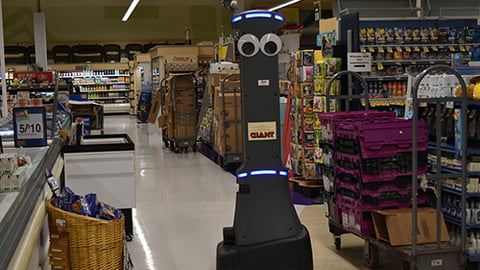Increasing Efficiency in Today’s Stores
In some respects, today’s stores would be unrecognizable compared with those of 50 years ago. The latest technology has upended traditional in-store processes in favor of more efficient, streamlined systems. This is especially true when you consider what Amazon has done to move the grocery industry forward (imagine the confusion on a grocery store manager’s face from the 1960s if they saw a store with no employees or checkout counters). Everywhere we look, we’re exposed to the revolutionary technology of today’s grocery store, from self-checkout to order-picking robots.
As these innovations flood the store, grocers want to ensure that new initiatives such as self-checkout, delivery and click-and-collect are proving profitable to the bottom line. The reality is that simply adopting these programs isn’t enough to ensure more revenue. Grocers need to complement new technology with efficient processes within the workforce. Empowered workers are the key to unlocking technology’s potential and ultimately improving the shopping experience for customers.
Empower the Workforce to Empower the Tech
A Salesfloor study found that 72 percent of hourly retail associates are more likely to stay with a retailer if they have the right technology and resources, and two-thirds said that access to digital tools and technology is a must-have at a future retailer. Stores that want their associates to succeed and excel must invest in relevant technology and easy-to-use tools that can make a difference in productivity and customer service. Let’s take a closer look.
Mobile
A simple way to ensure that associates are informed and connected is to embrace mobile options. Retailers recognize this, which is why, according to BRP Consulting, 49 percent of retailers name in-store mobile experience a top priority. For example, coordinating click-and-collect and delivery can be complicated if associates are just radioing each other when an order is placed, printing out a shopping list or taking other antiquated steps to fulfill orders. Similar to how customers turn to mobile apps to communicate with their favorite brands, handheld devices and apps can be extremely useful in communicating with operational systems and coordinating tasks. Tablets and similar devices alert associates when an order needs to be filled, what items need to be picked, where those items are located and where to meet the shopper with the items.
Robotics
Introducing robots into the aisles of a store isn’t as futuristic an idea as it may sound. Seen on show floors and in countless articles, these robots are capable of picking items, scanning shelves for inventory, and more to reduce the workload placed on associates. Last year, Albertsons announced an initiative using robots to pick items for online orders where AI-enabled technology and conveyors will bring the ordered goods to an Albertsons employee, who will manually compile the order. Meanwhile, Walmart has invested heavily in piloting robots in stores for a variety of purposes – including unloading boxes from delivery trucks, checking items on the shelves, changing price labels on products, and selecting items for online grocery. Retailers are recognizing that any efforts to automate mundane in-store tasks will enable associates to perform at a higher level and provide a more rewarding work experience.
Shelf-Edge Technology
Another technology that can make new in-store initiatives more efficient is that of electronic shelf labels (ESLs). These labels easily serve as a critical store operations tool, helping to free up associates so they can focus on better serving customers and pursue more meaningful tasks at hand. For example, since they’re no longer spending time manually changing prices, associates can help with other customer-facing services and store-wide initiatives, such as assisting with click-and-collect orders and stepping in to help coworkers handle tasks during a busy day.
In addition, ESLs can help store associates with merchandising, inventory management and picking orders. They can help call out certain items to help click-and-collect pickers find a requested product more quickly. Additionally, after hours, they can display inventory details and advice to expedite merchandising and product organization.
No matter what avenue retailers take, new technology requires that retailers reconsider how the workforce is used. Not all solutions are simply plug-and-play. As such, improving the existing ecosystem to complement new technology can take the burden off associates, help create a seamless omnichannel experience and improve associate use to create an efficient store.












